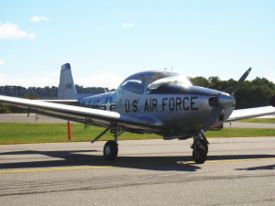PlaneSpottingWorld welcomes all new members! Please gives your ideas at the Terminal.
Navion
| Navion | |
|---|---|
| Type | Light Prop |
| Manufacturer | North American Aviation / Ryan Aeronautical |
| Introduced | 1948 |
| Status | Active |
| Primary users | United States Military Private Owners |
| Number built | 1,200+ |
The Navion is a light, four-seat aircraft originally designed and built by North American Aviation, later built by Ryan Aeronautical Company and the Tubular Steel Corporation (TUSCO).
Contents
Development history
The Navion was originally designed at the end of World War II by North American Aviation as the NA-143 (but produced under the NA-145 designation). It was designed for the civilian market but also attracted the interest of the United States Army Air Forces. The Army Air Force ordered 83 of the NA-154 version, designated the L-17A, to be used as a liaison aircraft, personnel and cargo carrier, and trainer for the university-based Reserve Officers Training Corps flight training program, 35 of which were later converted to L-17C by the Schweitzer Aircraft Company by fitting them with L-17B model features such as an auxiliary fuel tank.
Ryan Aeronautical Company acquired the design in 1948, and built approximately 1,200 examples over the following three years. Ryan designated the airplane the Navion A and, later, the Navion B (with 260 hp engines of either the Lycoming GO-435-C2 or optionally the Continental IO-470 engine. The A Navions became the base for the military L-17B. A single prototype Navion C was developed to compete for the procurement that was awarded to Beechcraft (resulting in the T-34). This prototype did not survive. TUSCO took over production of the Navion in the mid 1950s, manufacturing D, E, and F models with a variety of enhancements including tip tanks and flush rivets. TUSCO also introduced the Rangemaster G model in 1960, which replaced the Navion's sliding canopy with a door. Sales of the aircraft were helped by the visibility of several famous celebrities who flew them, including Arthur Godfrey, Mickey Rooney, and Bill Cullen. Senator Jake Garn is a current Navion owner.
The Navion was envisioned as a plane that would perfectly match the expected post war boom in civilian aviation. It was felt that wartime pilots would want to come home and continue flying with their families and friends under more peaceful conditions, but the post war boom in civilian aviation did not materialize to the extent the manufacturers envisioned. Republic offered an Amphibious aircraft, the Seabee and Beech (now Raytheon) offered the Bonanza. Of all these aircraft, the Bonanza by far the most successful. All of these aircraft were significantly more advanced than prewar civilian aircraft and they set the stage for aircraft to be built from aluminum sheets riveted to aluminum formers. Before the war, light civilian aircraft typically were made of wood or steel tube fuselages with wooden wings, such as the Piper Cub and Aeronica Champ. These later planes were marketed after the war, but did not sell.
Present day
As of 2005, many Navions are still flying. The American Navion Society, formed in 1960, provides information to help Navion owners maintain and fly their airplanes, and organizes conventions and other social events for Navion owners.
Another more recently formed group Navion Skies provides additional support.
Popular Culture
In the 1972 made-for-television film "Family Flight", starring Rod Taylor and Dina Merrill, a family flying a Navion is forced down in the desert and later attempts to land the Navion on an aircraft carrier.
Military Operators
Specifications (L-17)
General characteristics
- Crew: 1 pilot
- Capacity: 3 passengers
- Length: 27.25 ft (8.3 m)
- Wingspan: 33.38 ft (10.17 m)
- Height: 8.53 ft (2.60 m)
- Wing area: 241 ft² (22.40 m)² estimated
- Empty: varies, depending on equipment
- Loaded: 2,750 lb, (1,247 kg)
- Powerplant: Continental E185, 185/205 hp (138/153 kW)
Performance
- Never Exceed speed: 190 mph (306 km/h)
- Cruise speed: 155 mph
- Stall speed: 64 mph gear and flaps up, 50 mph gear and flaps down
- Range: varies with auxiliary tanks
- Service ceiling: 15,000 ft
- Rate of climb: 1,250 fpm
- Wing loading: 11.4 lb/ft² (55.7 kg/m²) estimated
- Power loading: 13.4 lb/hp (8.1 kg/kW) estimated, Navion A modelbb
Sources
- Ryan Aeronautical Company. Navion Operation Manual (3rd ed., February 1, 1949).
- U.S. Bureau of Aeronautics. Technical Order 1L-17A-1: Flight Handbook USAF Series L-17A, L-17B, and L-17C Aircraft (1 October 1948)
- Aviation Consumer. Used Aircraft Guide
- American Navion Society web site
- L-17.org web page
- Warbird Alley L-17 web page
External links
- American Navion Society
- Navion Skies web site
- L-17.org
- Warbird Alley L-17 page
- Fraser Blues Navion formation demonstration team


